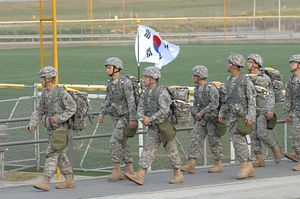The impeachment of President Park Geun-hye plunges South Korea deeper into political turmoil. Anticipating another North Korean provocation, Defense Minister Han Min-koo called on Thursday for heightened vigilance among the Republic of Korea (ROK) armed forces. But it will be left largely to incoming U.S. President Donald Trump to steer us through the looming mayhem.
The South Korean National Assembly voted 234-56 on Friday to impeach Park for her corruption scandal. With roughly half of the ruling Saenuri Party members defecting to join opposition forces in favor of impeachment, it’s now up to a Constitutional Court to validate the vote and either pave the way for early elections or restore Park’s powers.
In the midst of Korea’s abrupt and potentially sharp political transition (the leading presidential candidate, left-leaning Moon Jae-in, promises to undo some of Park’s recent security policy decisions, including on missile defense and intelligence cooperation with Japan), the United States will make a critical political transition of its own on January 20, when Barack Obama hands over the keys to the White House to Donald Trump.
North Korea has suggested that it would refrain from provocations for a few weeks, perhaps until U.S.-ROK military exercises scheduled for February. That means the Trump administration will be in office barely a month before a predictable crisis occurs, and it must make the management of disorder on the Korean Peninsula a top priority.
First, President Trump should double down on deterrence. This means working through the U.S.-ROK alliance to reinforce deterrence and prevent renewed outbreak of war. Unlike the 1950-53 Korean War that produced the current Armistice, new conflict could precipitate a nuclear conflagration.
The potential for miscalculation is nontrivial. Even without Park’s downfall, the democratic transitions in the United States and the ROK were bound to create more vulnerability. Kim, perceiving irresolution and chaos in South Korea and the United States, might seize the moment to provoke with the aim of winning new concessions. Kim could underestimate alliance resolve and matters could escalate.
For these reasons, Trump’s security team should build on recent attempts to buttress deterrence.
Twenty-three years after his grandfather Kim Il-sung catalyzed a nuclear crisis by abandoning the Nuclear Non-Proliferation Treaty, the grandson is on the cusp of fielding a nuclear weapon capable of striking U.S. soil. One does not have to argue that the deployment of an intermediate- or intercontinental-range ballistic missile capable of hitting Guam and North America would change everything to see that it would create a more perilous situation.
President Trump will not remain idle amid a gathering threat. Deterrence can be maintained by explicit declaratory policy, visible displays of military power, and vigorous crisis management preparation.
But beyond this essential first step, President Trump should also seek a bottom-up review of U.S.-ROK alliance strategy for comprehensively thwarting the mounting danger posed by Kim.
Updating the alliance strategy for North Korea, to focus on more than sanctions, should be the second pillar of Trump’s response to the present crisis.
Trump will want to enact harsh sanctions and undertake a serious crackdown on Kim’s illicit global financing operations. But he will also recognize that cutting off all economic ties to North Korea enhances China’s leverage over North Korea and, by extension, over the peninsula. China is then likely to use any additional influence to maintain the status quo and not move forward on denuclearization, because instability on its border is the greater threat to Beijing.
A strategic review will not halt the pursuit of sanctions, but it will also not make sanctions the centerpiece of strategy. Hence, the three aims of a North Korea strategy by the U.S.-ROK alliance should be as follows:
- If possible, change the cost-benefit calculus of Kim and his goal to make North Korea a nuclear-weapon state on a par with Pakistan;
- Deter, contain, penalize, and constrain Kim if he – as is probable – continues to pursue a stockpile of nuclear weapons and multiple means of delivering them, even to U.S. soil; and
- Enhance military readiness to defeat North Korea should it trigger a conventional conflict.
The overall aim of an alliance strategy review should be to devise ways to make sure Kim understands this basic message: nuclear weapon acquisition will threaten your survival, not guarantee it.
Third, because this strategy will require a comprehensive approach, a Trump administration should look anew at how to use the entire policy toolkit. This will include the following four instruments:
- Economic carrots and sticks to persuade and shape North Korean behavior, but also an economic growth strategy for the U.S.-South Korean relationship to ensure that the alliance thrives while North Korea festers.
- Diplomatic pressure on North Korean malfeasance, but diplomatic flexibility should Pyongyang demonstrate any seriousness about living up to its past commitments regarding denuclearization. Trump will not let protracted, empty negotiations about a peace accord legitimize North Korea’s bid for nuclear-weapon-state status.
- Information warfare for crisis management and shaping North Korea over the long-term at both elite and grassroots’ levels.
- A strong defense posture to undergird a comprehensive strategy. In addition to short-term measures to preserve ironclad deterrence, Seoul and Washington have various options to exploit cutting-edge technologies to improve missile defenses.
Finally, the Trump administration must keep its eye on the big picture. Cold war has prevailed on the peninsula since 1953. Attempts at détente – including through the Basic Agreement, Agreed Framework, and Six-Party Talks – have all failed. Peace could emerge through a democratic, unified peninsula, but there is no peaceful means of achieving that end state.
Trump should see that a cold war with North Korea is likely to endure. Certainly cold war is preferable to hot war. It is also the minimum that the United States and South Korea need to achieve during this time of political upheaval.
Dr. Patrick M. Cronin is Senior Director of the Asia-Pacific Security Program at the Center for a New American Security (CNAS).

































